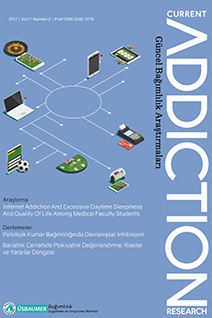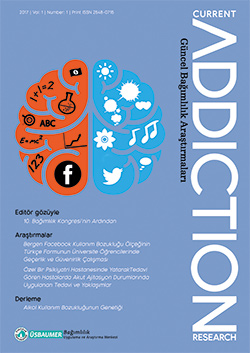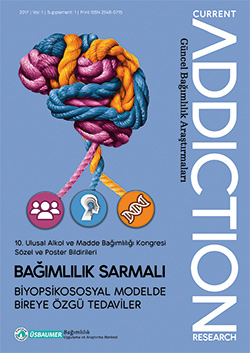Years
2025
2024
2023
2022
2021
2020
2019
2018
2017
Categories
Authors
- AYŞEGÜL DUMAN (1)
- Ahmet Tamer AKER (1)
- Ahmet Üzer (1)
- Ali Yücel GÜLER (1)
- Aslı Enez Darçın (1)
- Aslı Kayacan (1)
- Aslıhan Polat (1)
- Ayşegül Tosuner (1)
- Azize TÜRKOĞLU (1)
- Başak Ünübol (1)
- Berhudan Şamar (1)
- Beyza Yaz (1)
- Birgul Kekliltepe (1)
- Bülent COŞKUN (1)
- Cemal Onur NOYAN (3)
- Cemal Onur Noyan (2)
- Ceren GÜNGÖR (1)
- Ceylan Ergül Arslan (2)
- Davut Genç (1)
- Deniz Doğan (1)
- Deniz Eryılmaz (1)
- Derya Gündüz Hoşgör (1)
- Didem Beşikçi Keleş (1)
- Dilan Erkan (1)
- Ekin Sönmez Güngör (1)
- Elif Mutlu (1)
- Erkal ERZİNCAN (1)
- Erkal Erzincan (2)
- Fatma Betül Esen (1)
- Fatma Eren (2)
- Feyza ÇELİK (1)
- Gizem Akülker (1)
- Gul Eryılmaz (1)
- Gökben Hızlı Sayar (1)
- Gül ERYILMAZ (2)
- HANDE TUĞÇE DEMİRCİ (1)
- HATİCE OKSAL (1)
- Habib Erensoy (1)
- Hasan Kaya (1)
- Hasan Mervan Aytaç (1)
- Hatice Turan (2)
- Haydar Hoşgör (1)
- Hüseyin Ünübol (2)
- HİLAL ÇERKEZOĞLU (1)
- Hızlı Sayar Gökben (1)
- Işıl Gogcegoz (2)
- Işıl GÖĞCEGÖZ (1)
- Kursad Nuri Baydili (1)
- Lütfiye Nur Akkoç Arabacı (1)
- Melike Yerebakan Tüzer (1)
- Merve Metin (1)
- Meryem Zeynep Uğurlu (1)
- Mine Ergelen (1)
- Murat Yalçın (1)
- Nermin GÜNDÜZ (2)
- Nermin Gündüz (2)
- Nesrin Dilbaz (2)
- Nevzat Tarhan (1)
- Nilüfer SAATCİOĞLU TINKIR (2)
- Nisanur Sarıgül (1)
- Nuran Korkmaz (1)
- Onur Gökçen (1)
- SALİH GÜLEN (1)
- Selim Arpacıoğlu (1)
- Sema AKKOYUN (1)
- Serdar Nurmedov (2)
- Sevinç Sütlü (1)
- Sümeyra Bilgiç (1)
- Tijen Acar (1)
- Tonguç Demir Berkol (1)
- Tuba Öcek Baş (1)
- Tuğba Yılmaz (1)
- Yasin Hasan Balcıoğlu (1)
- Zehra Arıkan (1)
- Zeynep Ülke (1)
- Zeynep Şahin (1)
- Zühal Albayrak (1)
- Çağrı Yalçın Çınar (1)
- ÖMER BÜBER (1)
- Özge Kutlu (1)
- Özge Nur Kutluer (1)
- Özge Timur (1)
- İrem Teke Bulut (1)
- Şule DOYAROĞLU (1)
ARTICLES
Original Article
Comparison of the Attachment Styles of Cigarette Smokers and Nonsmokers
Beyza Yaz,Hüseyin Ünübol,Gökben Hızlı Sayar
2019, 3(1), s:11-15
Aim: This study aimed to compare the attachment styles of smokers and nonsmokers.
Methods: 2800 individuals who participated in the study were given sociodemographic form and “Experiences in Close Relationships Scale”.
Results: Younger ages, male sex, low educational levels found to be related to smoking status. However smoking status or the number of daily smoked cigarettes not found to be related to attachment style.
Conclusion: According to the results of the study, attachment styles were not significantly different according to smoking status. The results of this study suggest that the other comorbid psychopathologies might be a more important risk factor than attachment style in smoking.
Original Article
Haydar Hoşgör,Derya Gündüz Hoşgör
2019, 3(1), s:16-24
Objective: The aim of this study is to examine the effect of the fear of missing out on the nomophobia, and to determine whether differences between these variables and demographic features.
Method: In accordance with this purpose, the students who were studying at the Department of Health Management in 2017-2018 autumn semester at universities in Istanbul were included in this study and data of 273 respondent were evaluated. Personal information form and FoMO and Nomophobia scales were used for data collection. Descriptive statistics, t-test, correlation and regression analyses were used in the data analysis.
Results: According to the analysis outcomes, the levels of nomophobia and FoMO of the students are above average. The results of the study demonstrate that there is a significant relation at a moderate level and positive direct relationship between nomophobia and fear of missing out, as well as the fear of missing out explains 30% of nomophobia. Also, the results show that there are statistically significant differences between students’ levels of nomophobia and fear of missing out, and their demographic features. Moreover, these differences are stem from students who control his smartphone at least 33 times a day, carry a continuous charger, control his smartphone as soon as waking up, connect to the social media via the smartphone.
Conclusion: It has been concluded that for future healthcare manager candidates, the fear of missing out on social networks is a predictor of nomophobia, also known as the fear of being deprived of the smartphone.
Original Article
Ayşegül Tosuner,Zehra Arıkan
2018, 2(2), s:39-46
Objective: To identify the prevalence of violence in alcohol and drug abusers and a control group; to determine the relationship between violent behavior and impulsivity, anger, aggression, traumatic childhood experiences and indicate whether prevalence of violence differs between periods of deprivation, soberness and while under the influence of alcohol/drugs.
Method: 49 alcohol abusers and 31 drug abusers aged 15-65 years were compared among themselves and also with 62 healthy controls; using a questionnaire including questions related with sociodemographic characteristics of violence, the Buss-Perry Aggression Scale, Barratt Impulsivity Scale, the State-Trait Anger Scale, the Childhood Trauma Questionnaire, Hamilton Depression Scale, the State-Trait Anxiety Inventory.
Results: The prevalence of psychological violence was 85%, physical violence 54%, sexual violence 6% and economic violence 10%. Significant differences were found in most of the variables among the groups, which were thought to be related to violent behavior.
Conclusion: In addition to medical treatment for addiction, psychotherapeutic interventions focusing on personality traits in areas such as anger control and impulsivity should be adopted. The fact that violence decreases in sober periods indicates that violence is rather a result of the nature of the substance.
Original Article
Predictors for Fear of Missing Out in the Social Networks Among University Students
Çağrı Yalçın Çınar,Elif Mutlu
2018, 2(2), s:47-53
Objective: Social networks have become indispensable of our lives with the spread of the internet. The increase of time spent on social networks led to appear a new consept of fear of missing out. The purpose of this research was to determine predictors for Fear of Missing Out (FoMO) among university students.
Method: The sample of the research was 400 Kırklareli university students who were determined by random sampling method. The data was collected using personal information form, Life Satisfaction Scale, BAPI Internet Form, FoMO Scale, Rosenberg Self-Esteem Scale, Five Factor Personality Scale and Adult ADHD Self-Report Scale. SPSS Statistical Software package was used in the analysis of the data.
Results: As a result of research, Fear of Missing Out was found to be higher among students who also find lessons boring and check social media hourly especially in during the course who have low self-esteemand in the first grade. Inaddition, it was determined that internet addiction,neurotic features, attention deficit and hyperactivity have positively associated with FoMO.
Conclusion:Internet addiction, impulsivity and neurotic features are determined as influential factors in the emergence of FoMO.
Original Article
Evaluation of Memory Functions of Alcohol Dependent Patients
Serdar Nurmedov
2018, 2(1), s:5-10
Long-term alcohol use causes varying degrees of deficit in various cognitive functions including learning, memory, visuospatial functions and abstraction. Studies using different techniques indicate that the neocortex, particularly the frontal lobe; limbic system and cerebellum are the brain regions most vulnerable to the toxic effects of alcohol.
The aim of this study is to assess the memory function in individuals with a history of alcohol dependency who meet the criteria for at least early partial remission and to compare it with healthy controls. The study also aims to investigate the association of memory function with duration of abstinence.
Twenty-four patients and 24 age, sex and education matched healthy controls were included in the study. Patients with Axis-I comorbidity, chronic neurological disease, dementia, chronic disease, Wernicke encephalopathy, Korsakoff syndrome and history of head trauma were excluded. The memory function of alcohol dependent individuals and healthy controls was assessed with Wechsler Memory Scale (WMS) and Rey Auditory- Verbal Learning Test (AVLT).
The memory subscales that show significant difference between the dependent and control groups are immediate memory span, total scores of learning trials and learning false score in AVLT and forward digit span, backward digit span, visual reproduction and memory quotient in WMS. Statistically significant difference was found in the long term recall score and long term false recognition score between the early and sustained full remission subgroups.
As a result of this study, dependent subjects are found to show more deficit in attention and memory functions compared to healthy controls. These findings are consistent with the literature on this subject.
Original Article
Sociodemographic Examination of Patients Applying to Probation Policlinic in Erzurum Province
Fatma Eren,Nermin Gündüz,Hatice Turan,Erkal Erzincan
2018, 2(1), s:11-16
Objective: In this first study on the patients who applied to the Probation Ward in the Eastern Anatolian Region of Erzurum province, it is aimed to compare the sociodemographic data of the patients with the substance use characteristics and other legal crimes.
Method: Between December 2015 and February 2016, 132 patients who applied for the first time to the Erzurum DS polyclinic were included in the study. The sociodemographic data form prepared by the researchers participating in the research was applied.
Results: All of the 132 cases involved in the study were men. While 49.2% of the patients had multiple substance use, cannabis was found to be the highest substance alone at 45.4% level. We found that smoking and alcohol use started earlier than substance use and that alcohol and cigarette use were high. Considering the impact of multiple substance use on the sociodemographic data, a significant difference was found between early substance use age, substance abuse existence in the past month, the first cigarette smoking age, self-harm behavior presence, the existence of additional criminal cases and the existence of previous psychiatric treatment history. There was a significant positive correlation between the age of first substance use and the age, the age of first cigarette use and the age of first alcohol use. Finally, when the groups with and without prison stories are compared in terms of self-harm behavior, a significant difference was found.
Conclusion: Reviewing the sociodemographic data of individuals with probation application will guide clinicians in defining the group in which more preventive measures will be taken for substance use.
Original Article
The Comparison of The Theory of Mind in Internet Addicted And Non-Addicted University Students
Nuran Korkmaz,Hızlı Sayar Gökben,Hüseyin Ünübol,Nevzat Tarhan
2018, 2(1), s:17-21
Aim: The purpose of this study is to compare the university students having diagnosed as internet addicted and internet non-addicted in terms of the theory of mind.
Methods: The study group consisted 50 undergraduate students at Üsküdar University. 25 students diagnosed an internet addicted composed the study group. 25 students who have same sex with the study group subjects, however do not have any internet addiction, composed the study group.
Results: The average age of the students is 22.74±1.45. Data was collected by using sociodemographic data form, Internet Addiction Scale and the Dokuz Eylül Theory of Mind Scale. The study group found to have statistically significantly lower scores in theory of Mind Scale, when compared to the control group.
Conclusion: This result suggests that internet addiction may affect the students’ social interaction, emotional and cognitive processing.
Original Article
Nermin Gündüz,Özge Timur,Erkal Erzincan,Hatice Turan,Onur Gökçen,Fatma Eren,Aslıhan Polat
2017, 1(2), s:56-63
Objective: Considering the increasing use of the internet among university students, medical faculty students are thought to be particularly sensitive because of the time they spend on the internet and because of intensive practical and theoretical course schedules. In this study, we aimed to examine the prevalence of internet addiction and also relationship between internet addiction and excessive daytime sleepiness and quality of life. among the medicine faculty students. We aimed to examine the prevalence of internet addiction and also relationship between internet addiction and excessive daytime sleepiness and quality of life among medical faculty students.
Method: This study was carried out among the students of Erzurum Atatürk University Medical Faculty. In this cross-sectional study, sociodemographic data form created by researchers, Young Internet Addiction Scale, SF-36 and Epworth Sleepiness Scale were applied after the signing of the voluntary affirmation document to the medical faculty students.
Results: A total of 274 medical faculty students from various classes were included in the study. 61,32% of the students were found to have internet addiction. 53.28% of them were at mild level, 8,04% of them were at moderate level. There was a positive correlation between internet addiction scale total score and epworth sleepiness scale total score. There was negative correlation between internet addiction and each subscale of SF 36.
Conclusion: This study is the first study to evaluate internet addiction, excessive daytime sleepiness and quality of life among medical faculty students. In our study group internet addiction was determined as one of the reasons for excessive daytime sleepiness. That’s why we must focus on the treatment of internet addiction which is a serious problem in social context in recent years.
Original Article
Zeynep Ülke,Cemal Onur Noyan,Nesrin Dilbaz
2017, 1(1), s:16-25
Objective: The objective of this study was to adapt the “Bergen Facebook Addiction Scale (BFAS)” developed by Adreassen et al (1) into Turkish, and to evaluate the reliability and validity of the Turkish version of the Bergen Facebook Addiction among university students.
Method: The study was conducted in 2015 at Uskudar University and Yeditepe University (Istanbul-Turkey) with a total of 300 students from different majors and age groups. The draft scale was finalized after being translated and corrected by experts in the relevant fields. To determine the validity of the scale; factor analysis was performed and the results revealed that, of the 6 items reflecting the six core elements. It was detected that all items were distinctive with respect to relationship of each item with its related factor. Reliability level was determined by test – retest and internal consistency analysis. In addition, to test the criterion dependence validity of the scale, the correlation between the data gathered from Bergen Facebook Addiction Scale was analyzed respectively with data collected from the Smartphone Addiction Scale, Facebook Use Variance and Facebook Addiction Self-evaluation.
Results: The internal consistency coefficient was calculated using the Cronbach’s Alpha formula and gave a result of crα= .89. The 3-week test-retest validity Cronbach’s alpha was .76 for the six-item Bergen Facebook Addiction Scale. The factor analysis and testretest results confirmed the reliability and validity of the 6-item scale.
Conclusion: Bergen Facebook Addiction Scale is able to measure reliably, and the scale is a valid and reliable tool to be employed in a clinical environment to predict addiction levels of individuals regarding Facebook use in the Turkish society as well.
Original Article
Treatment And Approaches On Acute Agitation Among in Patients in a Private Psychıatry Hospital
Aslı Enez Darçın,Cemal Onur Noyan,Serdar Nurmedov,Hasan Kaya,Nesrin Dilbaz
2017, 1(1), s:26-32
Aim: It is aimed to determine the association between the indications of acute agitation call, applied treatment, applied restraint and seclusion with the
sociodemographical and clinical characteristics of psychopathology.
Method: Among inpatients in a private psychiatry hospital, medical records of whom has a form filled for acute agitation between June 2013-April 2014 examined
retrospectively, 137 medical records enrolled. Acute intervation form and brief psychiatric rating scale points that had been filled in the same day were determined.
Results: In the duration of the study acute agitation call applied for 16.4% of inpatients, 1.9% were restrained, 8% were secluded and 9.4% were given acute medication.
While the applied physical restraint and seclusion rates did not differ during the day, drug applications were found in higher rates during daytime hours (p<0.05). According to the hours of application, the duration of physical restraints were constant throughout the day while the duration of seclusions were longer in the night hours (p<0.05). The most common causes of acute agitation were aggression, threat of violence and treatment rejection. There was no difference approaches to acute agitation in terms of the diagnosis. The majority of selected drug treatments for acute agitation were intramuscular injections. No association was found between scale scores and the duration of any application.
Conclusion: Lower rates of restraints in our study could be associated with that the sample of this study was chosen from a private psychiatry hospital. There is need
for further training among treatment team and studies in this area to shed light on the development of approaches.



 2. Sayı
2. Sayı
 1. Sayı
1. Sayı
 Ek Sayı
Ek Sayı







